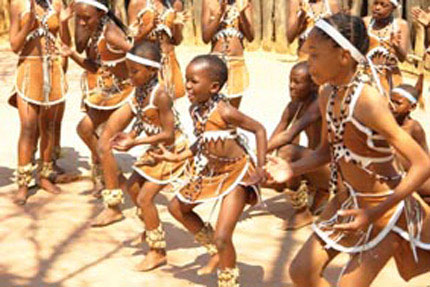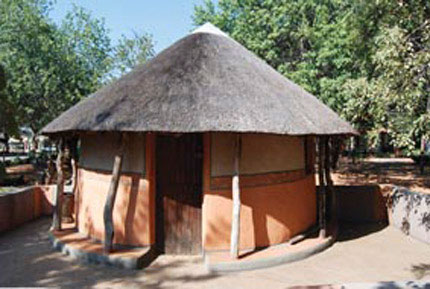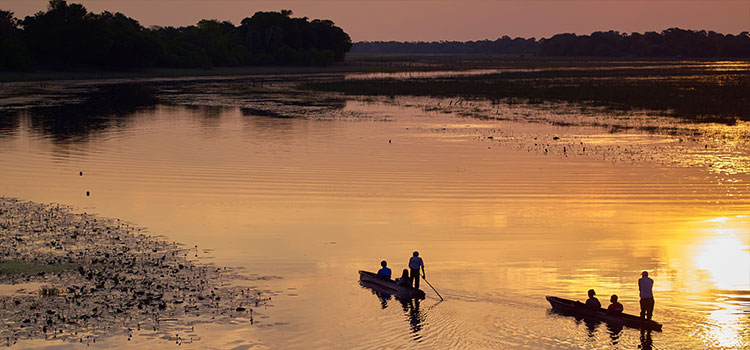

Rainmaking stories told through dance

Dance is about more than just entertainment in Botswana. Here, dancing is a vehicle that can transport people to an ethereal place where they can imagine meeting the gods and conversing with them.
Dancing can help ease the ailments of the weak and ill. So in times of trouble as well as happiness the people of Botswana lose themselves in various dances, because dancing is actually story-telling here.
That’s why, on this 50th anniversary of independence, the Mophato Dance Theatre in Gaborone has brought to life a great Botswana story of rainmaking with an amazing production entitled ‘Pula’ (meaning ‘rain’).
‘Pula’ is choreographed by Andrew Kola and had its debut at this year’s Maitisong Arts Festival in April. It has been described by art critics and the local media as Botswana’s greatest theatre production. Based on a remarkable story of rainmaking, ‘Pula’ is an authentic Botswana tale that has captivated lovers of national culture. It’s the story of a relationship between people and rain in a harsh desert climate; the story of how the people survived by learning to make it rain.
The tale is told through amazing dances, exciting poetry and haunting music.
Legend of Botswana
The play recounts a legend of Botswana’s traditional rainmakers, who were overshadowed by Christianity. It was a sacred skill that allowed the Batswana to find comfort in the arid desert conditions. People trusted the rainmakers, who had this hallowed ability to charm the clouds and quench the desert’s thirst.
The play begins during a bad drought when the rains are refusing to come and ‘new age’ rainmakers from the African Christian churches (an African adaptation of Christian beliefs) in their colourful gowns, bearing the crucifix, perform the dance known as ‘Dihosana’ to plead for rain. It is a desperate scene in which pleading for rain is a confused act between traditional African beliefs and modern foreign beliefs. But still the rains will not come.
So after some intense dances that yield no rain, the lead dancer, wearing a leopard skin to indicate he is the chief, approaches the traditional rainmaker and begs him to ask the gods to make it rain. The rainmaker throws the bones and orders the chief to go and ask his people to dance. The chief obeys the traditional rainmaker’s instructions and heads to the village, where the dancing continues.
Fever pitch
The dancing reaches fever pitch – beautifully enacted by the dancers in the Mophato Theatre production. At one point they appear to be in a genuine trance and it is no longer a work of art but a real-life ritual of begging for rain. And that’s when the ‘rains’ pour down on stage in the form of sorghum, the staple crop of Botswana.
After the sorghum ‘shower’ there is more dancing as the performers enact the story of what happens after the much-awaited rains.
There are jubilant dances and charming household chores such as fetching water, all depicted in a beautiful and traditional choreography.
The show also depicts the delighted wild animals rejoicing after the long-awaited rains. This impressive cultural production closes with a spectacular presentation of traditional dances from all the regions of Botswana. This dance parade at the close makes ‘Pula’ the complete one-hour package for anyone seeking to experience a Botswana traditional dance.
Dance is about more than just entertainment in Botswana. Here, dancing is a vehicle that can transport people to an ethereal place where they can imagine meeting the gods and conversing with them.
Animal Skins
Dressed only in animal skins, the dance troupes are usually an equal mix of men and women. Dancers wear shells round their ankles and some male dancers also carry whistles. The only accompaniment is the beat of drums.
Traditional troupes ensure that dance styles are kept alive, and the San dance style ‘tsutsube’ and Setswana ‘setapa’ remain popular. The internationally known Mogwana, a professional dance troupe based in Gaborone, sets a high standard in terms of performance and adherence to traditional dancing styles.
Every August, dance aficionados head to the Kalahari to enjoy the Kuru San Dance Festival. At the festival, various San groups, including the Naro, the !Xun, the !Khwe, the Dxana/ Dcui and the Xhanikwe, seize the opportunity to show off their culture to an international audience.
Dancing can help ease the ailments of the weak and ill. So in times of trouble as well as happiness the people of Botswana lose themselves in various dances, because dancing is actually story-telling here.
That’s why, on this 50th anniversary of independence, the Mophato Dance Theatre in Gaborone has brought to life a great Botswana story of rainmaking with an amazing production entitled ‘Pula’ (meaning ‘rain’).
‘Pula’ is choreographed by Andrew Kola and had its debut at this year’s Maitisong Arts Festival in April. It has been described by art critics and the local media as Botswana’s greatest theatre production. Based on a remarkable story of rainmaking, ‘Pula’ is an authentic Botswana tale that has captivated lovers of national culture. It’s the story of a relationship between people and rain in a harsh desert climate; the story of how the people survived by learning to make it rain.
The tale is told through amazing dances, exciting poetry and haunting music.
Legend of Botswana
The play recounts a legend of Botswana’s traditional rainmakers, who were overshadowed by Christianity. It was a sacred skill that allowed the Batswana to find comfort in the arid desert conditions. People trusted the rainmakers, who had this hallowed ability to charm the clouds and quench the desert’s thirst.
The play begins during a bad drought when the rains are refusing to come and ‘new age’ rainmakers from the African Christian churches (an African adaptation of Christian beliefs) in their colourful gowns, bearing the crucifix, perform the dance known as ‘Dihosana’ to plead for rain. It is a desperate scene in which pleading for rain is a confused act between traditional African beliefs and modern foreign beliefs. But still the rains will not come.
So after some intense dances that yield no rain, the lead dancer, wearing a leopard skin to indicate he is the chief, approaches the traditional rainmaker and begs him to ask the gods to make it rain. The rainmaker throws the bones and orders the chief to go and ask his people to dance. The chief obeys the traditional rainmaker’s instructions and heads to the village, where the dancing continues.
Fever pitch
The dancing reaches fever pitch – beautifully enacted by the dancers in the Mophato Theatre production. At one point they appear to be in a genuine trance and it is no longer a work of art but a real-life ritual of begging for rain. And that’s when the ‘rains’ pour down on stage in the form of sorghum, the staple crop of Botswana.
After the sorghum ‘shower’ there is more dancing as the performers enact the story of what happens after the much-awaited rains.
There are jubilant dances and charming household chores such as fetching water, all depicted in a beautiful and traditional choreography.
The show also depicts the delighted wild animals rejoicing after the long-awaited rains. This impressive cultural production closes with a spectacular presentation of traditional dances from all the regions of Botswana. This dance parade at the close makes ‘Pula’ the complete one-hour package for anyone seeking to experience a Botswana traditional dance.


